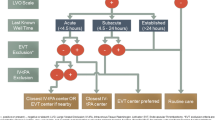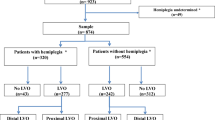Abstract
Patients with acute ischemic stroke (AIS) due to large vessel occlusion (LVO) should be triaged to an endovascular-capable hospital by the emergency medical service (EMS). We designed a prehospital LVO prediction scale based on EMS assessments. In the derivation cohort, 1157 patients transferred to our hospital by the EMS because of suspected stroke within 24 h of onset were retrospectively examined. Factors associated with AIS due to LVO were identified based on the EMS assessment, and a prehospital scale identifying LVO was developed. The accuracy of this scale was validated in 502 consecutive patients who were transferred to 4 stroke centers, and its accuracy was compared with those of 4 previously reported scales. AIS due to LVO was diagnosed in 149 of 1157 patients (13%) in the derivation cohort. One point each was assigned for facial palsy, arm weakness, consciousness impairment (cannot say his/her name), atrial fibrillation, and diastolic blood pressure ≤ 85 mmHg, with two points for conjugate eye deviation (FACE2AD scale). In the derivation cohort, with the optimal cut-point of FACE2AD ≥ 3 determined by the area under the curve (AUC; 0.88; 95% confidence interval 0.87–0.90), sensitivity, specificity, positive predictive value, and negative predictive value for FACE2AD to predict LVO were 0.85, 0.80, 0.39, and 0.97, respectively. In the validation cohort, the FACE2AD scale had higher accuracy, with an AUC value of 0.84 for predicting LVO compared with the other scales (all p < 0.01). The FACE2AD scale is a simple, reliable tool for identifying AIS due to LVO by the EMS.



Similar content being viewed by others
Change history
08 January 2020
The original version of this article unfortunately contained mistakes.
References
Goyal M, Menon BK, Van Zwam WH, Dippel DWJ, Mitchell PJ, Demchuk AM, et al. Endovascular thrombectomy after large-vessel ischaemic stroke: a meta-analysis of individual patient data from five randomised trials. Lancet. 2016;387:1723–31.
Nogueira RG, Jadhav AP, Haussen DC, Bonafe A, Budzik RF, Bhuva P, et al. Thrombectomy 6 to 24 Hours after stroke with a mismatch between deficit and infarct. N Engl J Med. 2018;378:11–21.
Mctaggart RA, Torbey MT, Tenser MK, Mazwi TL, Sarraj A, Kasner SE, et al. Thrombectomy for stroke at 6 to 16 Hours with selection by perfusion imaging. N Engl J Med. 2018;378:708–18.
Powers WJ, Rabinstein AA, Ackerson T, Adeoye OM, Bambakidis NC, Becker K, et al. 2018 Guidelines for the early management of patients with acute ischemic stroke: a guideline for healthcare professionals from the American Heart Association/American Stroke Association. Stroke. 2018;49:e46–99.
Perez de la Ossa N, Carrera D, Gorchs M, Querol M, Millan M, Gomis M, et al. Design and validation of a prehospital stroke scale to predict large arterial occlusion: the Rapid Arterial Occlusion Evaluation Scale. Stroke. 2014;45:87–91.
Katz BS, McMullan JT, Sucharew H, Adeoye O, Broderick JP. Design and validation of a prehospital scale to predict stroke severity: Cincinnati Prehospital Stroke Severity Scale. Stroke. 2015;46:1508–12.
Lima FO, Silva GS, Furie KL, Frankel MR, Lev MH, Camargo ÉCS, et al. Field assessment stroke triage for emergency destination. Stroke. 2016;47:1997–2002.
Hastrup S, Damgaard D, Johnsen SP, Andersen G. Prehospital acute stroke severity scale to predict large artery occlusion: design and comparison with other scales. Stroke. 2016;47:1772–6.
Suzuki K, Nakajima N, Kunimoto K, Hatake S, Sakamoto Y, Hokama H, et al. Emergent large vessel occlusion screen is an ideal prehospital scale to avoid missing endovascular therapy in acute stroke. Stroke. 2018;49:2096–101.
Ohta T, Kikuchi H, Hashi K, Kudo Y. Nizofenone administration in the acute stage following subarachnoid hemorrhage. Results of a multi-center controlled double-blind clinical study. J Neurosurg. 1986;64:420–6.
Yoshimura S, Sakai N, Okada Y, Kitagawa K, Kimura K, Tanahashi N, et al. Efficacy of endovascular treatment for acute cerebral large-vessel occlusion: analysis of nationwide prospective registry. J Stroke Cerebrovasc Dis. 2014;23:1183–90.
Yamashita S, Kimura K, Iguchi Y, Shibazaki K, Watanabe M, Iwanaga T. Kurashiki prehospital stroke subtyping score (KP3S) as a means of distinguishing ischemic from hemorrhagic stroke in emergency medical services. Eur Neurol. 2011;65:233–8.
Kubo M, Kiyohara Y, Kato I, Tanizaki Y, Arima H, Tanaka K, et al. Trends in the incidence, mortality, and survival rate of cardiovascular disease in a Japanese community: the Hisayama study. Stroke. 2003;34:2349–54.
Feigin VL, Lawes CM, Bennett DA, Barker-Collo SL, Parag V. Worldwide stroke incidence and early case fatality reported in 56 population-based studies: a systematic review. Lancet Neurol. 2009;8:355–69.
Wang W, Jiang B, Sun H, Ru X, Sun D, Wang L, et al. Prevalence, incidence, and mortality of stroke in China clinical perspective. Circulation. 2017;135:759–71.
Acknowledgments
We thank paramedics at Suita city fire department, Mino city fire department, Toyonaka city fire department, Ibaraki city fire department, Ikeda city fire department, Settsu city fire department, Toyooka city fire department, Nantan fire department, Mikata broader-based fire department, Kobe city department, and Nara wide area fire department.
Funding
This study was supported in part by the Intramural Research Fund for Cardiovascular Diseases of National Cerebral and Cardiovascular Center (H26-4-1).
Author information
Authors and Affiliations
Corresponding author
Ethics declarations
Conflict of Interest
The authors declare that they have no conflict of interest.
Ethical Approval
All procedures performed in studies involving human participants were in accordance with the ethical standards of the institutional and/or national research committee and with the 1964 Helsinki declaration and its later amendments or comparable ethical standards.
Informed consent
Informed consent was obtained in the form of opt-out on the web site. Those who rejected were excluded.
Additional information
Publisher’s Note
Springer Nature remains neutral with regard to jurisdictional claims in published maps and institutional affiliations.
The original version of this article was revised: The figure captions were incorrect.
Electronic supplementary material
ESM 1
(DOCX 13396 kb)
Rights and permissions
About this article
Cite this article
Okuno, Y., Yamagami, H., Kataoka, H. et al. Field Assessment of Critical Stroke by Emergency Services for Acute Delivery to a Comprehensive Stroke Center: FACE2AD. Transl. Stroke Res. 11, 664–670 (2020). https://doi.org/10.1007/s12975-019-00751-6
Received:
Revised:
Accepted:
Published:
Issue Date:
DOI: https://doi.org/10.1007/s12975-019-00751-6




